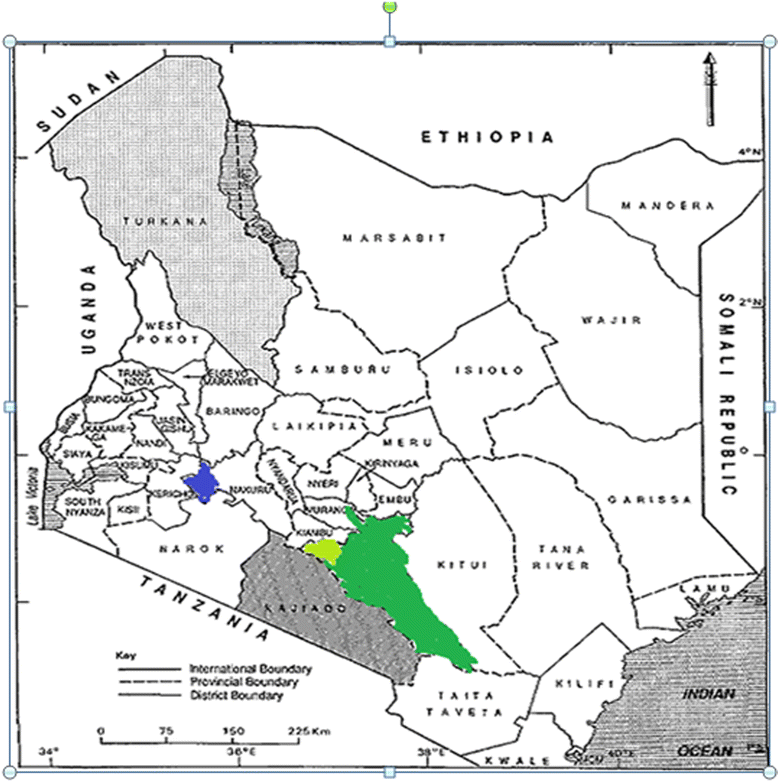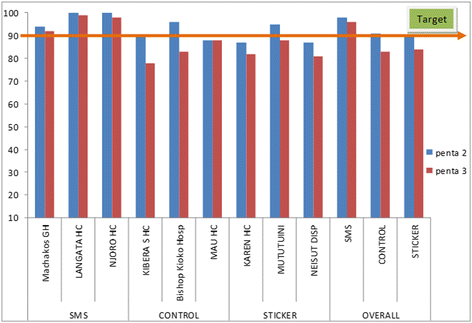Reducing routine vaccination dropout rates: evaluating two interventions in three Kenyan districts, 2014
- PMID: 26880141
- PMCID: PMC4754928
- DOI: 10.1186/s12889-016-2823-5
Reducing routine vaccination dropout rates: evaluating two interventions in three Kenyan districts, 2014
Abstract
Background: Globally, vaccine preventable diseases are responsible for nearly 20% of deaths annually among children <5 years old. Worldwide, many children dropout from the vaccination program, are vaccinated late, or incompletely vaccinated. We evaluated the impact of text messaging and sticker reminders to reduce dropouts from the vaccination program.
Methods: The evaluation was conducted in three selected districts in Kenya: Machakos, Langata and Njoro. Three health facilities were selected in each district, and randomly allocated to send text messages or provide stickers reminding parents to bring their children for second and third dose of pentavalent vaccine, or to the control group (routine reminder) with next appointment date indicated on the well-child booklet. Children aged <12 months presenting for their first dose of pentavalent vaccine were enrolled. A dropout was defined as not returning for vaccination ≥ 2 weeks after scheduled date for third dose of pentavalent vaccine. We calculated dropout rate as a percentage of the difference between first and third pentavalent dose.
Results: We enrolled 1,116 children; 372 in each intervention and 372 controls between February and October 2014. Median age was 45 days old (range: 31-99 days), and 574 (51%) were male. There were 136 (12%) dropouts. Thirteen (4%) children dropped out among those who received text messages, 60 (16%) among who received sticker reminders, and 63 (17%) among the controls. Having a caregiver with below secondary education [Odds Ratio (OR) 1.8, 95% Confidence Interval (CI) 1.1-3.2], and residing >5 km from health facility (OR 1.6, CI 1.0-2.7) were associated with higher odds of dropping out. Those who received text messages were less likely to drop out compared to controls (OR 0.2, CI 0.04-0.8). There was no statistical difference between those who received stickers and controls (OR 0.9, CI 0.5-1.6).
Conclusion: Text message reminders can reduce vaccination dropout rates in Kenya. We recommend the extended implementation of text message reminders in routine vaccination services.
Figures
References
-
- WHO, 2010 report. Countdown to 2015, Maternal, Newborn and child survival [Internet]. WHO. 2010 [cited 2015 Mar 13]. Available from: http://www.who.int/pmnch/media/press_materials/fs/fs_mdg4_childmortality.... Accessed 12 Feb 2016.
-
- Andersson N, Cockcroft A, Ansari NM, Omer K, Baloch M, Ho Foster A, et al. Evidence-based discussion increases childhood vaccination uptake: a randomised cluster controlled trial of knowledge translation in Pakistan. BMC Int Health Hum Rights. 2009;9(Suppl 1):S8. doi: 10.1186/1472-698X-9-S1-S8. - DOI - PMC - PubMed
-
- WHO. WHO | monitoring system. 2014 global summary Immunization Country Profile [Internet]. [cited 2014 Dec 11]. Available from: http://apps.who.int/immunization_monitoring/globalsummary/countries?coun.... Accessed 12 Feb 2016.
-
- WHO. vaccine-preventable diseases: monitoring system 2012 global summary - country profile: Kenya. 2012. http://apps.who.int/immunization_monitoring/globalsummary/countries?coun.... Accessed 12 Feb 2016.
Publication types
MeSH terms
Substances
LinkOut - more resources
Full Text Sources
Other Literature Sources
Medical



